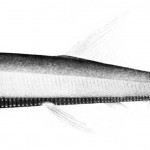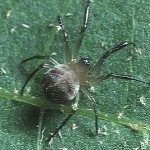The Devil You Know
by Heather Soulen
In our last installment of The Dark Side of Taxonomy, we’ve saved one of the most fear inducing scientific names for last. We wouldn’t have done due diligence this Halloween season if we didn’t mention him. In this piece we present a small collection of organisms that in some instances have suffered the same etymological fate – a scientists with a proclivity for dark humor. Here we spotlight organisms that carry the infamous name of an angel who fell from grace.
Satan
The widemouth blindcat (Satan eurystomus) is a North American freshwater catfish endemic to Texas in the United States. It’s blind, has no pigment and lives deep (1,000-1,250 feet) in dark subterranean artesian wells. The widemouth blindcat detects its prey by sensing electrical disturbances with its lateral line and barbels, and with its well-developed teeth is thought to be a top predator. Ichthylogist Carl Leavitt Hubbs was said to have a dark and warped sense of humor, and enjoyed naming subterranean cave fishes with diabolic names. The name Satan is of course meant to mean the Prince of Darkness while eurystomus is derived from the Greek word eurus for broad or wide and stomus referring to stoma, the Greek word for mouth.
Lucifer
- The Pacific astronesthid fish or Pacific snaggletooth (Astronesthes lucifer) lives in the dark depths (25-700 meters) of the Indo-Pacific. Many fish in this genus have a bioluminescent chin barbel that it uses to lure unsuspecting small prey into striking distance only to meet their demise by a mouth full of sharp needle-like teeth. Astronesthes is derived from the Greek word astra which means ray and esthes which means suit or something used to wrap.
- With a name like Forkbarbel netdevil (Linophryne lucifer), this fish must be a diabolical oddity. Linophryne lucifer is a north Atlantic fish that has been found off the coasts of Madeira, Newfoundland, and Iceland at depths near 300-600 meters. One of the most intriguing curiosities surrounding this fish species is that males are much smaller than females and are obligatory sexual parasites, meaning they cannot mature and reproduce without attaching to a female. Even more peculiar, females can have more than one male attached at any given time. This deep sea species feeds with the help of an illicium and luminescent esca that serve as a kind of rod and bait to lure unsuspecting prey towards its mouth. Linophryne is derived from the Greek word linon which means flax or something made of flax like a net, while phryne is Greek for toad. Put together it refers to a toad-like fish that fishes with a net.
- Lucifer faxoni has a few common names that include Lucifer shrimp, ghost shrimp and Faxon’s shrimp. It is a small (<1 inch) planktonic shrimp in the family Luciferidae. Dr. Walter Faxon (1848-1920), a zoologist at the Harvard Museum of Comparative Zoology, named the shrimp species after his own last name, a common practice amongst biologist of the day. Mainly found in the Western Atlantic, its range extends from Newfoundland’s Grand Banks southward to Brazil, and is found in the Chesapeake Bay. It is a voracious predator that quickly eviscerates and shreds its planktonic prey with its serrated mandibles. While one might assume that the genus Lucifer refers to the Prince of Darkness, the irony is that it comes from the direct Latin translation of the word (i.e. light-bearer) since members of the genus were found to be bioluminescent by John V. Thompson in 1829.
Baalzebub
Ray spiders of the genus Baalzebub are cryptozoic spiders found living in dark moist environments not unlike those found in the litter layers of forests or caves. These small (<3 mm) nocturnal spiders are widespread throughout the tropics and have been found in Mexico, Guatemala, Costa Rica, Panama, Columbia, Brazil, South Africa, Malaysia, New Guinea, Australia and New Zealand.
Beelzebub
The Beelzebub’s tube-nosed bat (Murina Beelzebub) was recently discovered in South East Asia in 2011. When asked about the bat’s diabolical name, one of the scientists responsible for the discovery stated, “We chose the name Beelzebub to reflect the dark ‘diabolic’ coloration of the new species and its fierce protective behaviour in the field.” These bats are small as suggestive of the genus name Murina which is derived from the Greek word minys, meaning little or small. Fitting since these bats are smaller than a human hand.




